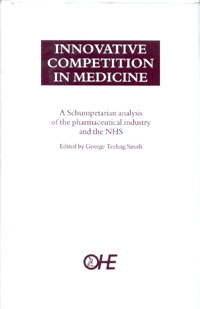Sign up to our newsletter Subscribe
Analysing Global Immunisation Expenditure

It is almost twenty years since I realised the significance of Schumpeter’s work to the pharmaceutical industry. But since the references to his conclusions in ‘The Canberra hypothesis’ in 1975, comparatively little attention has been drawn to the relevance of Schumpeter’s theory of…
It is almost twenty years since I realised the significance of Schumpeter’s work to the pharmaceutical industry. But since the references to his conclusions in ‘The Canberra hypothesis’ in 1975, comparatively little attention has been drawn to the relevance of Schumpeter’s theory of ‘creative destruction’ and the need for shelters against the ‘perennial gale’ of innovative competition in relation to pharmaceuticals.
Hence when I was encouraged to look again at industrial economic theory relevant to pharmaceutical pricing in 1991, it seemed opportune to draw attention to the 50th Anniversary of Schumpeter’s publication of ‘Capitalism, Socialism and Democracy’ in 1942. Although Schumpeter’s more general thesis that the bureaucratization of innovation would lead from classical entrepreneurial capitalism to a form of socialism has proved wrong, his chapters on the nature of innovative competition have largely stood the test of time. Indeed that is the very issue to which Professor Richard Nelson addresses himself to in the first chapter of the present book.
The book as a whole is based on a symposium in London in March 1992, entitled ‘A Perspective on Pharmaceutical Economics: 1942-1992’, held to mark the 50th Anniversary referred to above. The meeting, although it was excellently chaired by Lord Peston, did not altogether succeed in drawing together the threads of Schumpeterian theory and the current economic situation of the pharmaceutical industry. Indeed the papers by the Rt Hon Enoch Powell and Lord Jenkin strayed into the more general field of health care strategies as a whole. Nevertheless the seven papers taken together provide a wide and extremely interesting picture of the economics of innovation, the situation of the pharmaceutical industry, and the current issues facing the British National Health Service. They deserve a much wider audience than the hundred or so participants at the meeting itself. This is the logic behind the appearance of this book.
In fact the issues raised by the individual authors do have much more coherence than may at first be obvious. I have pointed out that the work of Schumpeter covered a much broader field than merely industrial innovation. He was concerned with the shift from the individual entrepreneur and inventor to a new type of industrial organisation and with the whole subject of change in social structure. These subjects, on which Schumpeter wrote so clearly in the early decades of this century, are just as relevant to Britain’s National Health Service as they are to the transnational pharmaceutical industry. Hence the issues covered in these chapters do in a very real sense each come back to Schumpeterian principles. Each of the authors has been conscious of the shadow of Schumpeter’s theories which fall over so much of industrialised and post-industrial society in the 1990s. That is what draws an apparently diverse set of essays into a cohesive whole and links each of them to the intended theme of the Symposium itself.
I hope that the readers of this book will derive as much interest from it as did, I believe, the audience in London in March 1992. It should certainly establish more formally the relevance of Schumpeter’s work to the economic study of the pharmaceutical industry in particular.
Innovative Competition in Medicine
Teeling Smith, G. ed.
(1992) Innovative Competition in Medicine. OHE Monograph. Available from https://www.ohe.org/publications/innovative-competition-medicine/

Notifications